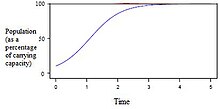User:Eni Katrini/sandbox

Most populations do not grow exponentially, rather they follow a logistic model. Once the population has reached its carrying capacity, it will stabilize and the exponential curve will level off towards the carrying capacity, which is usually when a population has depleted most its natural resources.
The Logistic Equation
Where,
= the population after time t
= time a population grows
= relative growth rate coefficient
= carrying capacity of the population; defined by ecologists as the maximum population size that a particular environment can sustain.[1]
The Analytic Logistic Solution
This is a separable differential equation that can be derived through integration.[2] The analytic solution is useful in analyzing the behavior of population models.
The equation is separable and to find the solution we integrate.
Working on just the left side of the equation, the fraction in the denominator is eliminated by multiplying the variable K, and then the fraction is split in 2.
The partial fraction is then integrated more easily.
After integrating and using U substitution, we get
Exponentiate both sides to get rid of the natural log. This is the equation that remains:
Get rid of the absolute value and split the into 2 parts.
Let and get
Solve for to get the explicit solution to the logistic equation as
; where and the initial population at time 0.
 | This is a user sandbox of Eni Katrini. You can use it for testing or practicing edits. This is not the sandbox where you should draft your assigned article for a dashboard.wikiedu.org course. To find the right sandbox for your assignment, visit your Dashboard course page and follow the Sandbox Draft link for your assigned article in the My Articles section. |




















